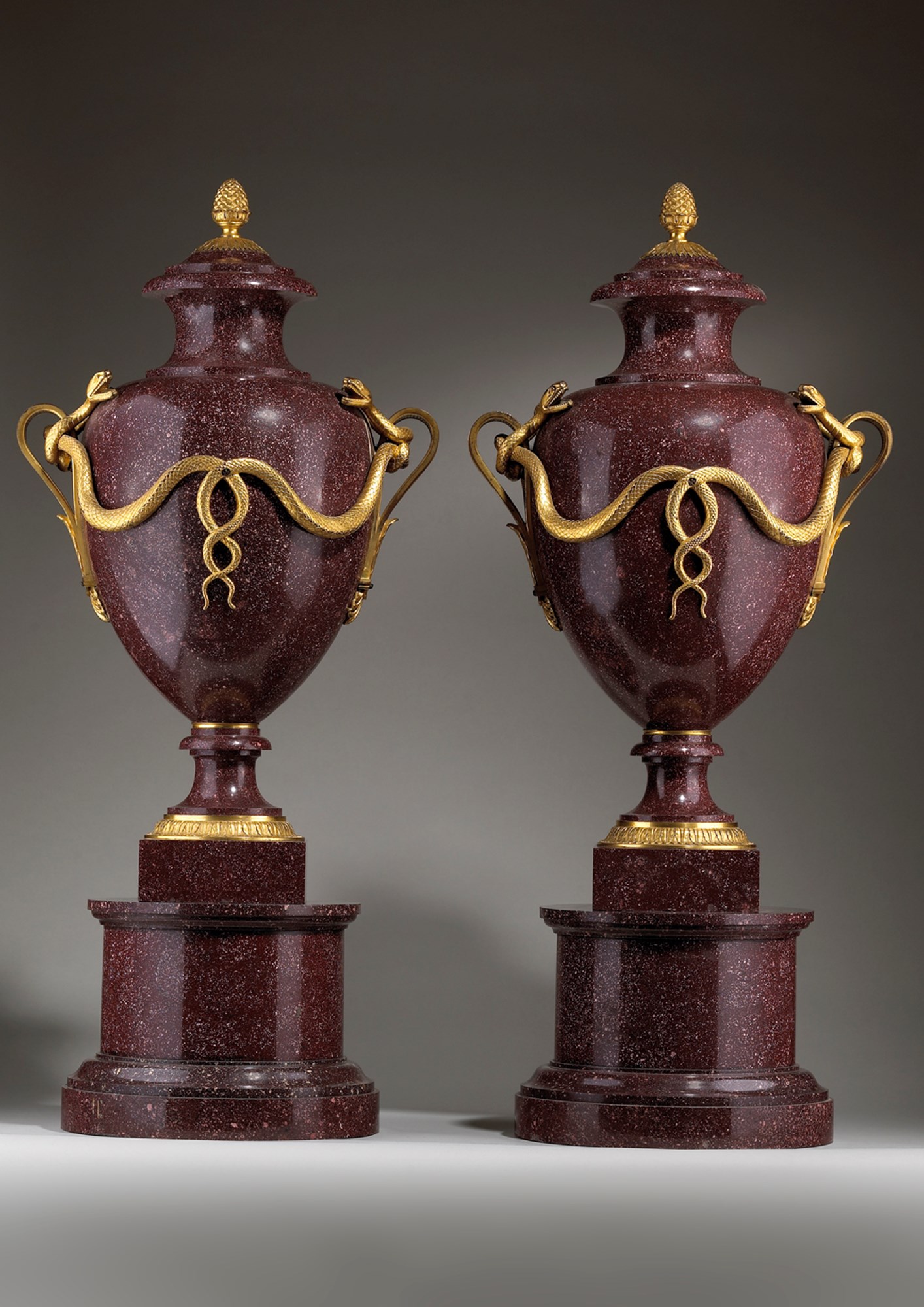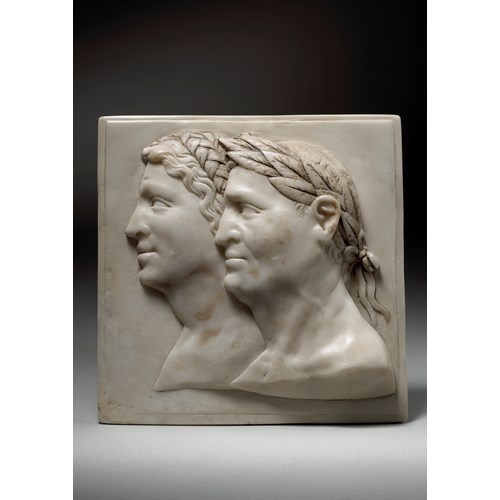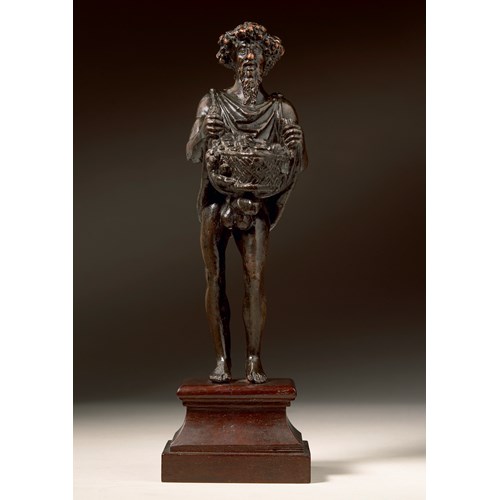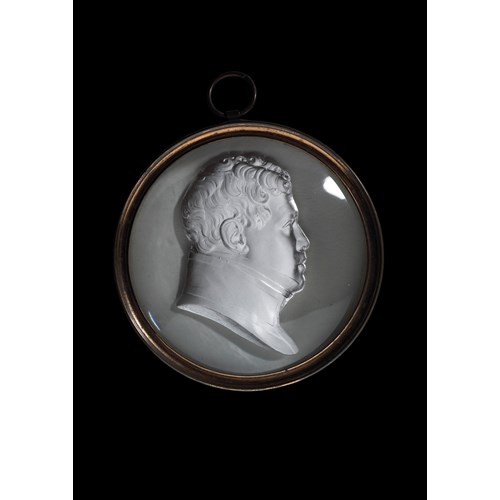Luigi Valadier
A Pair of Ormolu-mounted Imperial Porphyry Urns and Covers on Stands
Period circa 1780
Medium Imperial Porphyry and gilt bronze
Dimension 75 x 46 x 33 cm (29¹/₂ x 18¹/₈ x 13⁰/₁ inches)
on September 10, 1777, Empress Catherine II of Russia, also known as Catherine the Great, in a letter to
her trusted advisor Baron Friedrich Melchior von Grimm. The object of this most extraordinary collector’s
enthusiasm was a deser, or surtout de table - namely a centrepiece - by the celebrated Valadier workshop,
which she had acquired the same year from the Bailli de Breteuil, Ambassador of the Order of Malta to the
Holy See.
The son of a silversmith from Provence, Luigi Valadier was born in Rome in 1726 and, upon taking on his
father’s workshop, proceeded to become one of the most exceptional and accomplished artists of his age.
As well as a silversmith, he was a goldsmith and master bronzier, and designed a series of exquisite interior
ornaments, such as the present pair of urns, in pietre dure. Famously, he was entrusted by Pope Pius VI
with mounting the Vatican collection of antique cameos, for which he designed the cabinets where the
gems are displayed to this day, and with casting St Peter’s monumental bell, later completed by his son
Giuseppe (1761-1829).
Far from being alone in her praise of Valadier’s work, Catherine the Great was one of several monarchs
and aristocrats across Europe that had, throughout the years, actively sought and collected the Roman
artist’s unique creations. The Prince of Asturias, the future King Charles IV of Spain had purchased a
Valadier surtout, modelled after Rome’s Circus Maximus, also from the Bailli de Breteuil, and another
example, now in Louvre Museum, belonged to Luigi Braschi Onesti, Duke of Nemi and nephew of Pope
Pius VI. Others were recorded in the possession of Archduke Ferdinand of Austria, in the Borghese
collection, and also in that of the Portuguese ambassador to Madrid. Valadier also specialised in highly
finished church furnishings, such as silver reliquaries and chandeliers, and in bronze statues and statuettes
after the antique, from the monumental Dying Gaul he cast for the Dukes of Northumberland at Syon
House, to the Apollo Belvedere and Venus Callipyge for Madame du Barry. In addition, his patrons often
commissioned from Valadier decorations for entire rooms or parts of their palaces, as in the case of Maria
Flaminia Odescalchi and Sigismondo Chigi’s apartment in Palazzo Chigi, for which the artist supplied wall
mirrors, chimneypieces, bronze embellishments, silverware, and table furnishings such as precious
inkstands.
In other words, Valadier counted among his clients the most prestigious collectors of the age, and through
the doors of his studio walked illustrious visitors, from popes to future czars. Specifically, in March 1782
Valadier received a visit from the Comte and Comtesse du Nord, the titles assumed by Paul Petrovitch –
future czar Paul I – and his wife Maria Feodorovna while travelling through Europe. Their lavish purchases
from Valadier included a pair of candelabra in porphyry and gilt bronze (fig. 1), two white marble bas-relief
vases mounted in gilt-bronze (untraced), a set of four similarly ormolu-mounted porphyry vases on giallo
antico marble bases (fig. 2), two bronze putti on rosso antico pedestals (see A. González-Palacios, Luigi
Valadier, 2018, pp. 252-253), two pietre dure table-tops (untraced), and an Oriental alabaster vase on a rosso
base and mounted in gilt bronze (untraced) (for a full description, see A. González-Palacios, Luigi Valadier,
2018, pp. 247-257). The Comte and Comtesse were also recorded visiting the house of Thomas Jenkins (see
A. González-Palacios, Luigi Valadier, 2018, pp. 252-255), the noted antiquary and agent, from whom they
acquired a large porphyry vase (fig. 3) and a pair of porphyry vases mounted in gilt bronze (fig. 4), which
have been identified with specimens today at Pavlovsk Palace, the Palladian villa Catherine had built for
her son outside St Petersburg, where the surviving purchases from the atelier of Valadier are also displayed.
Alvar González-Palacios has attributed the pair of porphyry vases said to have come from Jenkins to
Valadier, recognising his genius in their “ornamental solutions that appear at once classical and modern”
(p. 254).
The above-mentioned group of ormolu-mounted porphyry vases and candelabra at Pavlovsk Palace,
executed by Valadier, present close resemblances with the present pair of urns, thus confirming their
attribution to the Roman master. Details such as the gilt-bronze pinecones atop the cover of each urn and
the intertwined serpents forming the handles find direct parallels in the Pavlovsk porphyries. For example,
the former can be observed in the pair of candelabra for the Comtes du Nord, while the latter coil on the
sides of the set of four small vases on giallo antico bases. In addition, the elegant proportions and very fine
finish of the present urns point in the direction of a workshop of the calibre of Valadier’s, famed for its
ability to combine precious hard stones with fine gilt-bronze decoration. The exceptional quality of the
cutting of the porphyry in particular, evident in the sharp precision of its edges, is indicative of a
manufacture of remarkable skill, one suited to the demands of a czar.
Notably, porphyry was renowned for its rarity and hardness, which required carving by artists of particular
skill. Quarried by the Romans between the first and fifth centuries A.D. in the mountains of Mons
Porphyrites, a group of hills in the Eastern Desert of Egypt, porphyry was considered the prerogative of
rulers and was closely associated with imperial power. In the eighteenth-century, when access to its
quarries had long been lost, porphyry was sourced from the limited supply of surviving ancient columns
and artifacts that could be re-carved, making it all the more prestigious. Within Valadier’s oeuvre, porphyry
is also employed for a pair of grand vases based on the Medici Vase executed for Madame du Barry (French
Mobilier National, Musée National des Châteaux de Versailles et de Trianon), for a pair of ormolumounted
candelabra commissioned by Prince Marcantonio Borghese (The Metropolitan Museum, New
York), and in the design for a vase with gilt-bronze candlesticks now in the Museo Napoleonico, Rome,
which appears to have never been realised, but bears similarities with the four small porphyry and giallo
antico vases in Pavlovsk. Most recently, a red porphyry pot-pourri vase from the collection of celebrated
designer Hubert de Givenchy, auctioned at Christie’s Paris (14 June 2022, lot 6), has been attributed to
Valadier, whose signature quality and level of finish in both the carving of the stone and casting of the gilt
bronze mounts has been recognised (fig. 5).
The former owner of the present pair of Imperial porphyry urns, Robert de Balkany (1931-2015), was a
noted business of Romanian origin who amassed a remarkable collection of European sculpture and
decorative arts, which he divided between his residences in Paris, the Côte d’Azur and Rome. Having
started his career in real estate in the United States, de Balkany was the first to import to France the
American model of the shopping centre, which sealed his success.
Period: circa 1780
Medium: Imperial Porphyry and gilt bronze
Dimension: 75 x 46 x 33 cm (29¹/₂ x 18¹/₈ x 13⁰/₁ inches)
Provenance: Robert de Balkany (1931-2015), Palazzo Lancellotti, Rome
Literature: A. Durand, Luigi Valadier au Louvre ou l'Antiquité exaltée, Paris, 1994
A. González-Palacios, L’Oro di Valadier: un genio nella Roma del Settecento, exh. cat., Villa Medici, Rome,
1997
A. González-Palacios, Luigi Valadier, exh. cat., Frick Collection, New York, 2018
More artworks from the Gallery









